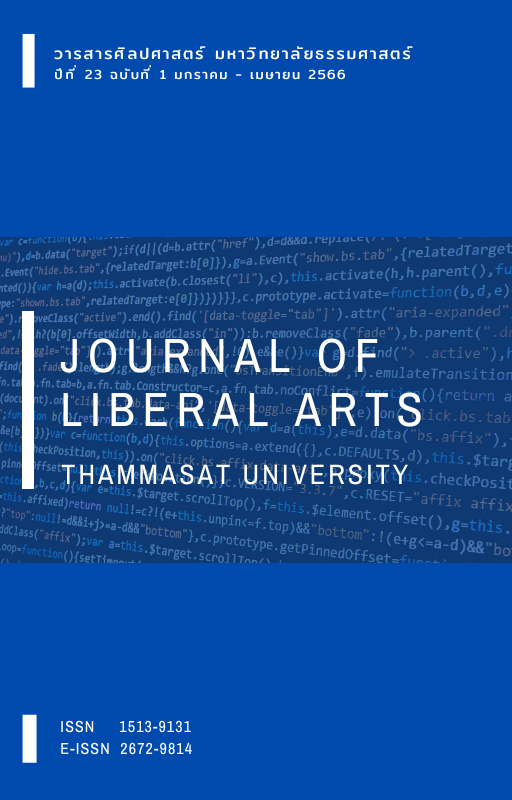ปริทัศน์ โดยปริยาย : วิดีโอเกม กระบะเล่นทราย
Main Article Content
บทคัดย่อ
บทความวิจัยนี้มีจุดประสงค์เพื่อทบทวนข้อเขียนต่าง ๆ เกี่ยวกับการศึกษาวิดีโอเกม และเพื่อสังเคราะห์ภาพรวมแนวทางการศึกษาวิดีโอเกม ผลวิจัยพบว่า 1) มิติการศึกษาด้านศิลปะวางอยู่บนฐานของความที่ไม่ชัดเจนในการพูดถึงความเป็นศิลปะ ขาดซึ่งการศึกษาประวัติศาสตร์และทฤษฎีศิลปะจากทั้งฝ่ายที่เห็นด้วยและไม่เห็นด้วยกับความเป็นศิลปะของวิดีโอเกม 2) การศึกษาเรื่องเล่าแสดงให้เห็นว่าวิดีโอเกมตั้งแต่ช่วงปลายศตวรรษที่ 20 มีการให้ความสำคัญกับเนื้อเรื่องมากขึ้น แต่ทว่าการศึกษาประเด็นเนื้อเรื่องจำเป็นต้องให้ความสำคัญกับกลไกการเล่นวิดีโอเกมด้วย เนื่องจากวิดีโอเกมจำลองสร้างเนื้อหาผ่านพฤติการณ์ มิใช่การบันทึกภาพแทนเหมือนกับภาพยนตร์และวรรณกรรม 3) การเล่นเป็นมิติการศึกษาเชิงสุนทรียศาสตร์ที่ผู้วิเคราะห์ให้ความสัมพันธ์กับประสบการณ์เล่นวิดีโอเกม และการออกแบบการเล่นเพื่อสร้างความสนุก การเล่นยังเป็นมิติด้านระเบียบวิธีวิจัยที่ผู้เล่นจำต้องเป็นชี้แจงและตระหนักว่าเล่นแบบไหน อย่างไร และกับใคร เนื่องจากว่าเนื้อหาวิดีโอเกมเกิดจากการจำลองความหมายที่มาจากผู้เล่น การศึกษาการเล่นจึงตอกย้ำว่าการศึกษาวิดีโอเกมคือการศึกษาเชิงประจักษ์นิยมและทฤษฎี ประจักษ์นิยมในความหมายว่าผู้วิจัยคือผู้มีส่วนร่วมในการสร้างเนื้อหาให้ประจักษ์และจับต้องได้ผ่านการเล่น และในเชิงทฤษฎีในความหมายที่ว่าผู้วิจัยต้องวิเคราะห์เนื้อหาที่ตัวเองสร้างมาอีกทีหนึ่งด้วยมุมมองเชิงทฤษฎี 4) การศึกษาด้านรูปแบบและการออกแบบเป็นวิธีการศึกษา มีความสำคัญกับการศึกษาวิดีโอเกมทั้งในแง่ที่ว่าองค์ประกอบของวิดีโอเกมยังไม่ชัดเจนเท่ากับสื่อประเภทอื่น ๆ และด้วยเหตุผลที่ว่าการสร้างรูปแบบวิดีโอเกมทำให้วิดีโอเกมมีน้ำหนักจับต้องเป็นวัตถุการศึกษาได้
Downloads
Article Details

อนุญาตภายใต้เงื่อนไข Creative Commons Attribution-NonCommercial-NoDerivatives 4.0 International License.
เอกสารอ้างอิง
Aarseth, E. J. (1997). Cybertext: Perspectives on Ergodic Literature. The Johns Hopkins University Press.
Aarseth, E. J. (2003). Playing Research: Methodological Approach to Game Analysis. Paper presented at the Spilforskning Dk Conference, August 28-29, 2003, Melbourne, Australia.
Aarseth, E. J. (2004). Genre Trouble: Narrativism and the Art of Simulation. In N. Wardrip-Fruin & P. Harrigan (Eds.), First Person: New Media as Story, Performance, and Game. The MIT Press.
Bogost, I. (2006). Comparative Video Game Criticism. Game and Culture, 1(1), 41-46.
Bogost, I. (2007). Persuasive Games: The Expressive Power of Videogames. The MIT Press.
Bogost, I. (2008). The Rhetoric of Video Games. In K. Salen (Ed.), The Ecology of Games: Connecting Youth, Games, and Learning (pp. 117-140). The MIT Press.
Bossa Studios. (2015). I am Bread [Computer Game]. Bossa Studios.
Channel Awesome. (2015, August 20). Are Video Games Art? [Video]. YouTube. https://www.youtube.com/watch?v=9VbNkDXfP_0
Consalvo, M., & Dutton, N. (2006). Game analysis: Developing a Methodological Toolkit for the Qualitative Study of Games. The International Journal of Computer Game Research, 4(1). http://gamestudies.org/06010601/articles/consalvo_dutton
Ebert, R. (2010, April 16). Video games can never be art. https://www.rogerebert.com/roger-ebert/video-games-can-never-be-art
Egenfeldt-Nielsen, S., Smith, J. H., & Tosca, S. P. (2020). Understanding Video Games: The Essential Introduction (4th ed.). Routledge.
Eskelinen, M. (2001). The Gaming Situation. The International Journal of Computer Game Research, 1(1). http://www.gamestudies.org/0101/eskelinen/
Felski, R. (2011). Context Stinks!. New Literary History, 42(4), 573-591.
Frasca, G. (2003). Simulation versus Narrative: Introduction to Ludology. In M. J. P. Wolf & B. Perron (Eds.), The Videogame Theory Reader (pp. 221-236). Routledge.
FromSoftware. (2009 - 2016). Dark Souls [Videogame Series]. Namco Bandai.
FromSoftware. (2015). Bloodborne [PlayStation 4 Game]. Sony Computer Entertainment.
Harman, G. (2012). The Well-Wrought Broken Hammer: Object-Oriented Literary Criticism. New Literary History, 43(SPRING 2012), 183-203.
Harman, G. (2017). Object-Oriented Ontology: A New Theory of Everything. Penguin Books.
Hocking, C. (2007, October 7). Ludonarrative Dissonance in Bioshock: The Problem of What the Game is About. https://clicknothing.typepad.com/click_nothing/2007/10/ludonarrative-d.html
House House. (2019). Untitled Goose Game [Nintendo Switch Version]. Panic.
Hunicke, R., Leblanc, M., & Zubek, R. (2004). MDA: A Formal Approach to Game Design and Game Research. Paper presented at the Challenges in Games AI Workshop, Nineteenth National Conference of Artificial Intelligence, San Jose.
Jones, J. (2012, November 30). Sorry MoMA, video games are not art. https://www.theguardian.com/artanddesign/jonathanjonesblog/2012/nov/30/moma-video-games-art
Juul, J. (2011). Half-Real: Video Games between Real Rules and FIctional Worlds. The MIT Press.
Levine, C. (2015). Forms: Whole, Rhythm, Hierarchy, Network. Princeton University Press.
Latour, B. (1999). Factures/fractures: From the concept of network to the concept of attachment. Res: Anthropology and aesthetics, 36(Winter 1999), 20-31.
Latour, B. (2004). Why Has Critique Run out of Steam? From Matters of Fact to Matters of Concern. Critical Inquiry, 30(Winter 2004), 225-248.
Latour, B. (2010). On the Modern Cult of the Factish Gods (C. Porter & H. Maclean, Trans.). Duke University Press.
Maxis. (2008). Spore [Computer Game]. Electronic Arts.
Morrow, A. (n.d.). If You're Still Berating Dean Takahashi, You Don't Understand How Games Journalism Works. Retrieved Dec 13, 2021 from https://www.gameskinny.com/o86oi/if-youre-still-berating-dean-takahashi-you-dont-understand-how-games-journalism-works
MrMoldovan. (2017, September 5). Which was worse? Dean Takahashi in Cuphead or the Grumps with that number block puzzle from Paper Mario?. https://www.reddit.com/r/pcgaming/comments/6y6tpg/a_games_journalist_plays_the_cuphead_tutorial/
Nintendo. (1985). Super Mario Bros [NES Game]. Nintendo.
Quantic Dream. (2018). Detroit: Become Human [PlayStation 4 Video Game]. Sony Interactive Entertainment.
Silva, I., Cardoso, P., & Oliveira, E. (2019). Narrative and Gameplay: The Balanced and Imbalanced Relationship between Dramatic Tension and Gameplay Tension. Paper presented at the ARTECH 2019: 9th International Conference on Digital and Interactive Arts, Braga, Portugal.
Studio MDHR. (2017). Cuphead [Computer Game]. Studio MDHR.
Supergiant Games. (2020). Hades [Computer Game]. Supergiant Games.
Takashi, D. (2017, September 8). The DeanBeat: Our Cuphead runneth over. https://venturebeat.com/2017/09/08/the-deanbeat-our-cuphead-runneth-over/
TEDx Talks. (2016, February 16). Are Games Art? | Brenda Romero | TEDxGalway [Video]. YouTube. https://www.youtube.com/watch?v=L5sBdR4-GGM
The Act Man. (2018, July 25). Why Is Dark Souls 1 A Masterpiece?! [Video]. YouTube. https://www.youtube.com/watch?v=LqhtBsxAZNo&t=196s
The Art Assignment. (2020, February 28). “The Case for Video Games” [Video]. YouTube. https://www.youtube.com/watch?v=afjbOpnJni0
The Closer Look. (2019, August 13). Why George RR Martin Is Wrong - (A Defence of Video Games) [Video]. YouTube. https://www.youtube.com/watch?v=Xs6qBDuY1ww&t=32s
The Game Overanalyser. (2018, December 1). What Video Games Can Do as an Artform | The Language of Games, and Why Video Games are Art [Video]. YouTube. https://www.youtube.com/watch?v=02HW4IJNGsU
USC Stevens Center for Innovation. (2010, July 30). Kellee Santiago: Are Video Games Art? [Video]. YouTube. https://www.youtube.com/watch?v=6GjKCnPQlSw
V. (2017, September 3). Dumbass journalist can't get past tutorial [Video]. YouTube. https://www.youtube.com/watch?v=zbE6fqBuGkA
Venturebeat. (2017, August 25). Cuphead Gamescom Demo: Dean's Shameful 26 Minutes of Gameplay [Video]. YouTube. https://www.youtube.com/watch?v=848Y1Uu5Htk
Weekend Warrior. (2017, September 11). The Curious Case of Dean Takahashi: A Critical Analysis and a Defense [Video]. YouTube. https://www.youtube.com/watch?v=knTuAEmhtVE
Witchayapakorn, K. (2021). Cut-scene, a Re-conceptualization of. Journal of Human Sciences, 22(1), 86-107.


